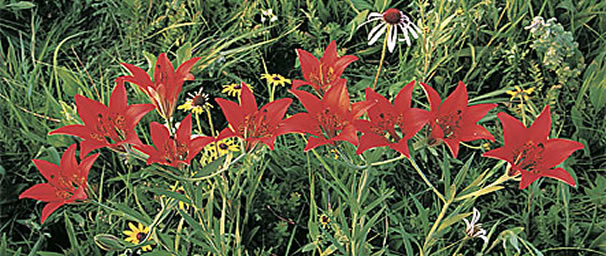Prairie lily - The summer queen
Lilium philadelphicum

June in western North Dakota - when the rain comes we have the pleasure of wild flowers in the native grasses. A standout among them is the bright orange, delicate-looking flower fluttering in the wind on the west and north sides of the buttes. The Prairie lily, Lilium philadelphicum, a member of the Lillium Family, has other names in other places. Because of its huge geographical range, from Quebec to British Columbia and southward to New Mexico, the Prairie Lily is also named Fire lily, Flame lily, Freckled lily, Red lily, Orange cup lily, Glade lily, and Wild Tiger lily. As the floral emblem of Saskatchewan it is called the Western Red Lily.The latin name, Lilium philadelphicum, is universal.
Linnaeus named this genus in 1753 andd the species in 1762. The species name, philadelphicum, honors Philadelphia, Pennsylvania from which he likely obtained his first specimen. Meriweather Lewis and Thomas Nuttall collected the specimen from the western United States.
In the North Dakota prairie, the Prairie lily is found in moist prairie that is not heavily grazed or mowed for hay. It does not usually flower if the summer is too dry. This lily is a favorite food of the local animals - deer eat the tender shoots, and gophers eat the bulbs. When gophers take the bulbs from underground, some of the scales from the sides of the bulbs fall off, and in time, may grow into lilies.
The Prairie lily's deep orange-red, purple-spotted flower spreads gracefully upward from a slender base at the top of the stem. Although the flower appears to have six petals, three of them are actually sepals, which are leaf-like structures that enclose the petals. Members of the Lily Family have leaves with parallel veins and flowers with parts in multiples of three. Male flower parts include the stamen, of which there are six on the Lily, and the anther, sometimes missing on this species. The female pistil has a 3-parted stigma.
The Native American Cree tribe named the Prairie lily the "wakican" or "mouse-root".The bulbs were dug when the flowers opened, then roasted, steamed, or boiled. When boiled, the bulb is purported to taste like a potato. Other uses included being ground into a meal for bread-making, and being used for a medicinal tea for stomach disorders, consumption, coughs and fever. Flowers were crushed or chewed, then placed on the bite of a brown spider.
Propagation is by seed. The seeds need to be placed in cold, moist stratification for 150 days before being sown in pots in a greenhouse or cold frame. The seedlings need regular feeding, and are best repotted when dormant. The plants can not be put out into the yard until their second year. Bulb scales can be removed from the bulbs in early autumn, kept in a warm, dark place in a bag of moist peat to produce bulblets. The bulblets can be potted and grown in a greenhouse until they are ready to be moved outdoors. If the seeds are planted directlly outdoors, they will not germinate until their second year, and flowers will not appear for three or four years. Bees and butterflies will pollinate the plants to form new seeds.
Whether in the wild, or propagated for your own yard, the Prairie lily is a flower to prize.
Citations
Baskin, Carol C.; Baskin Jerry M. 2002. Propagation protocol for production of coontainer Lillium philadelphicum L. Plants; University of Kentucky, Lexington, Ky. In: Native Plant network. URL: http://www.nativeplantnetwork.org/(accessed 29 September 2006). Moscow (ID): University of Idaho, College of Natural Resources, Forest Research Nursery.
Grondahl, Chris, and andrea Evelsizer. 2002. Prairie wildflowers and grasses of North Dakota. North Dakota Game and fish Department, Bismarck, ND Jamestown, ND:Northern Prairie WildlifeResearchCenter Online. http://www.nativeplantnetwork.org/ (accessed 29 September 2006)
Kantrud, Harold A. 1995. Native Wildflowers of the North Dakota Grasslands. Jamestown, ND: Northern Prairie Wildlife Ressearch Center Online. http://www.npwrc.usgs.gov/resource/%20plants/wildflwr/index.htm (accessed 29 September 2006)
Knight's Canadian Info Collection, Provincial and Territorial Flowers of Canada. http://members.shaw.ca/scic1/flowers.html (accessed 29 September 2006)
Lilliaceae: Wildflowers of the Lily Family. Pictures and help with Wildflower Identification. http://members.shaw.ca/scic1/flowers.html(accessed 29 September 2006)
Prairie Lily - Meet Your Neighbors - Summer 2004. Chicago Wilderness Magazine Summer 2004. http://members.shaw.ca/scic1/flowers.htmll (accessed 29 September 2006)
Plants For A Future, 1996-2003. Lilium philadelphium - Plants For A Future database report. http://www.pfaf.org/database/plants.php?Lilium+philadelphicum

